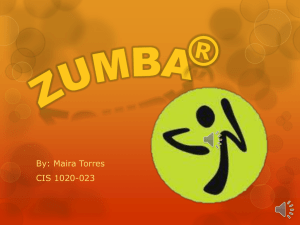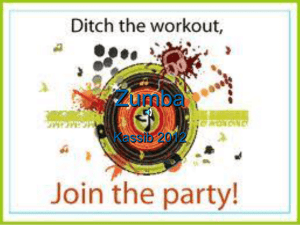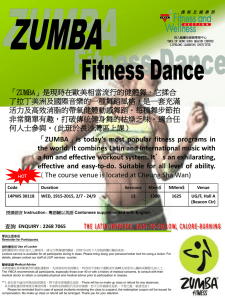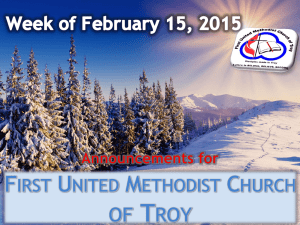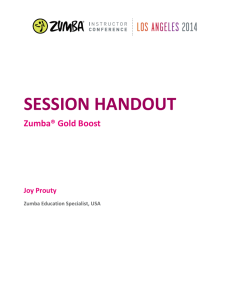Groove It Powerpoint
advertisement
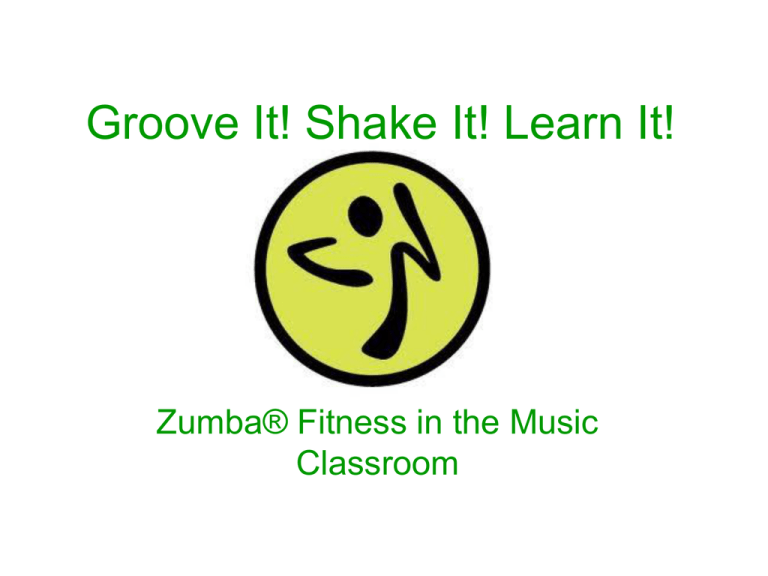
Groove It! Shake It! Learn It! Zumba® Fitness in the Music Classroom Agenda • Introduction • What is Zumba? • How I use Zumba at school • How I use Zumba in the classroom • Lesson Plans • Video Demonstration • Fundraisers • Pros and Cons of being a Zumba Instructor What is Zumba? • Zumba is a Latin based fitness program • The music and dances are primarily Latin but include other world rhythms What is Zumba? • Zumba exercises include music with fast and slow rhythms and resistance training for fitness and losing weight. • The music comes from the following dance styles: cumbia, salsa, merengue, mambo, flamenco, chachacha, reggaeton, soca, samba, belly dancing, bhangra, hip hop music, axé, and tango. What is Zumba? • There are seven different types of classes for different levels of age and exertion, including one based in the swimming pool. Zumba Classes Zumba Classes Zumba Classes Zumba Classes Zumba Classes Zumba Classes Zumba Classes Zumba at School • Students and I exercise every Monday, Wednesday, and Friday before school starts from 7:15-7:35 • These students tend be my “regulars” and don’t need to have moves demonstrated over and over • Some of the songs are from the Zumba corporation, many of the songs are from Kids Bop CD • Great way to get out of morning duty Zumba at School • Teachers and I exercise every Friday after afternoon post is over. • Typically 2:15-3:15 • Teachers receive a regular session of Zumba • Attendance varies due to people forgetting clothes, holidays, wanting to get out of school on Friday, or just plain forgetting that it happens every week Zumba in the Classroom • One of the things I have used Zumba for is preparing for Hispanic Heritage Month • Zumba can be a gateway to teaching the language, geography, and traditions of a culture. Lesson Plans • These are plans for teaching the Cumbia Step • We are using the 4th grade Silver Burdett Music Connection • Cumbia Lesson Plans 4th grade Class performing Cumbia • Here is one of my classes learning and performing the cumbia • Mrs. Rhodan’s Class Zumba in the Classroom • I have other grade levels performing different songs • For example, my 3rd graders will learn how to sing a song in Spanish during HHM but they have a recorder emphasis and will learn how to read the notes, do the fingerings, and play an accompaniment to the song they are learning. Zumba in the Classroom • I have used my Zumba certification to host events that are called Zumba in the Classroom • Basically, a Zumbathon is when people pay a certain price (usually ranging from $10-$20) to have a Zumba party for 2 hours. • It is non-stop dancing for 2 hours. • They can be used to benefit your classroom or school/PTA Zumba in the Classroom • We held a Zumbathon back in October for the music department at my school and raised $400 dollars New Drums and Percussion Pros and Cons of being a Zumba Instructor • Remember, you do not have to be Zumba instructor to teach ethnic dances in your classroom. Just don’t ever call it Zumba. • Also remember that you can use Kids Bop CDs and any ethnic music you may find. • If you think that getting Zumba certified is something you would like to do, then you need to know a few things to make an informed decision. Pros • • • • • Great exercise for your students and colleagues Gets you in shape Community building within your school You have the ability to host your own fundraisers Good way to make some extra money if you work for a gym or if you host individual events • Zumba sends you music and choreography notes Cons • The financial obligation – Pay for each type of class and there is a monthly fee to be a part of the Zumba Instructor Network(ZIN) • There are more people certified for Zumba than there are jobs. • If you plan on doing private parties or corporate events, you need to have your own insurance and sound system and be willing to pay for your own marketing materials. • Finally, the physical toll it takes on your body Questions?

